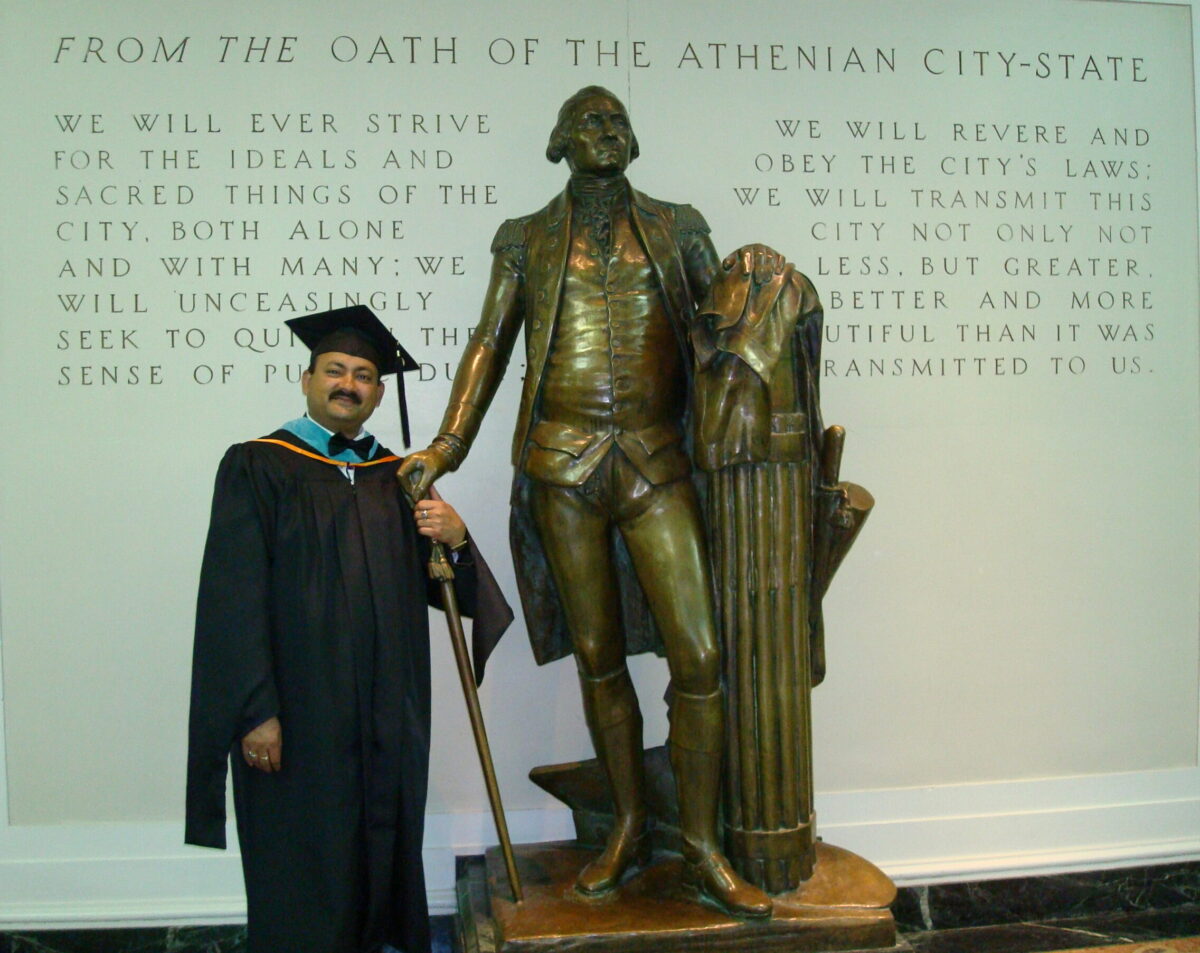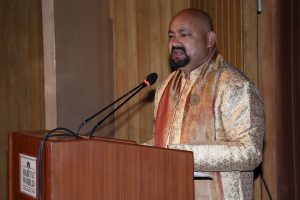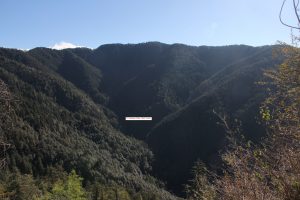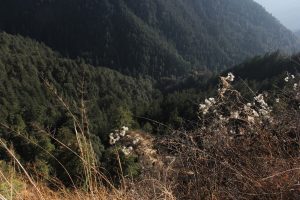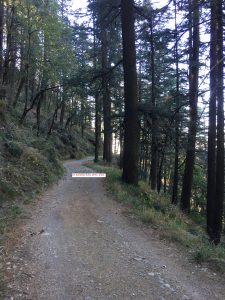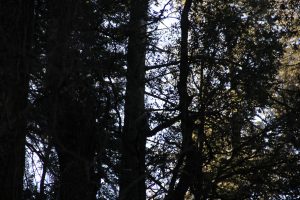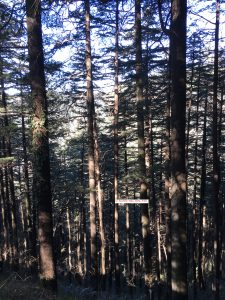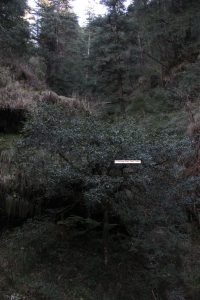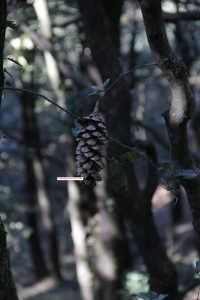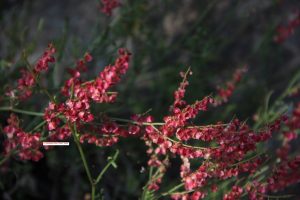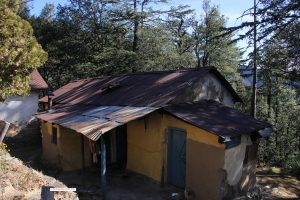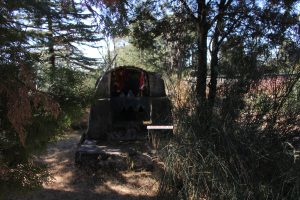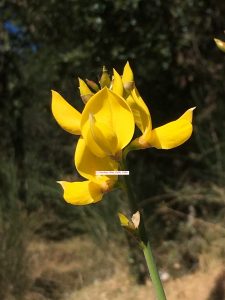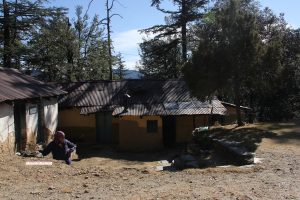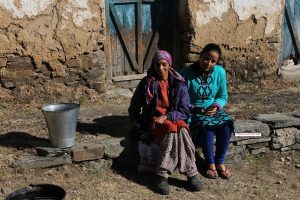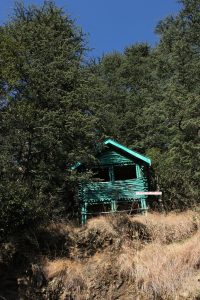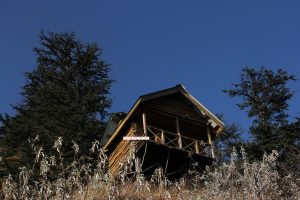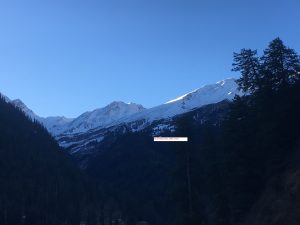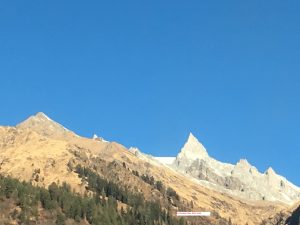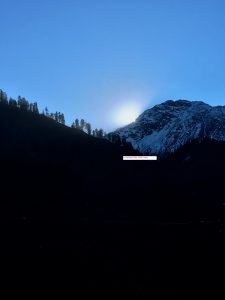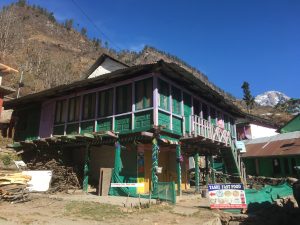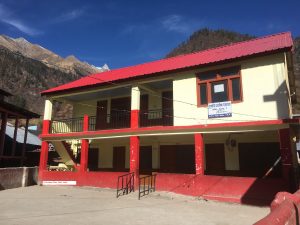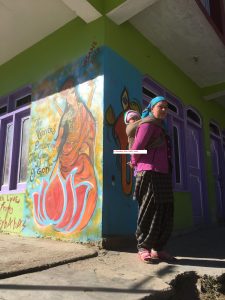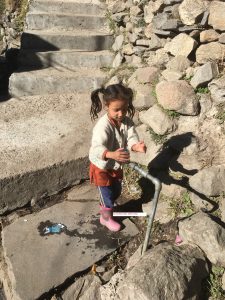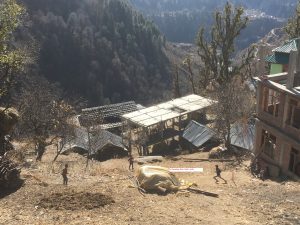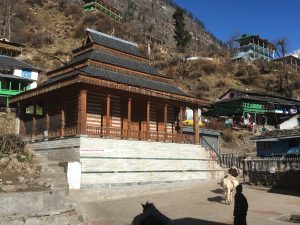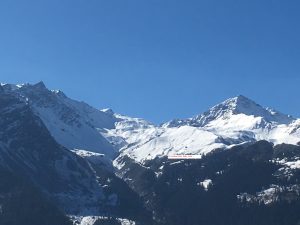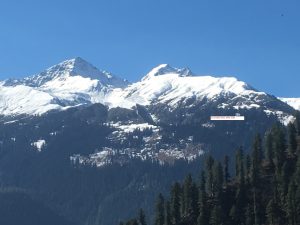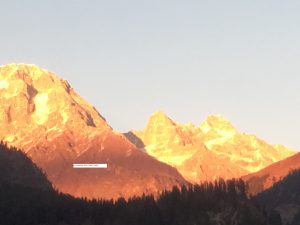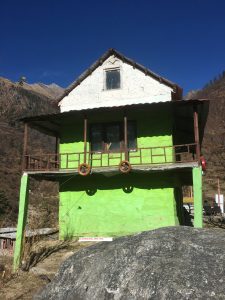https://www.youtube.com/watch?v=BIC_EhdXQFM&feature=youtu.be
Rann of Kutch… ocean of salt or salt of the earth? by Sandeep Silas
The Bible in the Gospel of Mathew 5:13 reveals a meaningful phrase:
- “You are the salt of the earth, but if the salt has lost its
- flavor, with what will it be salted? It is then good for nothing,
- but to be cast out and trodden under the feet of men.”
When I cast my eyes the first time on the Rann of Kutch I felt this come to me very powerfully. We had come to the White Rann by evening, my brother and I. We had first travelled from the Tent City by bus, then by camel cart to enter this territory that was for many years a salt wasteland without a human visitor.
Modern day travails and stressed out lives in the cities have led men to discover and reach such places to feel the grandeur of Nature and be engulfed with an awesome feeling. There is something beautiful and wondersome in Nature; it kind of overpowers the senses and tells you that all the efforts and boasts of Man are just empty whispers of the impermanent!
The Tent City is set up every year for six months when the weather is good and the salt is walkable, the slush having dried and the whiteness the best. The tents are comfortable and more than that give a feeling of adventure, a difference, which we all look for from daily routine.
The Sun was about to set and that gave us a spring in gait to walk as far ahead as possible from where there is no interference between the Sun’s glory and its colours as it dies another day, and the bewitched eyes.
The voices of onlookers created a noise that was incomprehensible to the ears. I was reminded of a play, in which we actors were to stand on stage and act as if engaging in avid conversation, while all we were to say was “gabble, gabble, gabble…” The Party in theatrics is nothing but gabble, gabble or bla, bla…
The majesty of the Sun was unparalleled. The more it went towards its imminent demise for the day, the more it glowed! Bright orange, blood red, mango yellow, and then a blob of red disappearing slowly but surely.
Its path for the day had been traversed, its duty done, it seemd to have set in our portion of the hemisphere but in fact it was rising in another. What a beautiful lesson in duty it is, to keep on shining with glory be it this part of the world or another. It also reveals that no Sun can forever shine in one part of the earth, it has to travel to another!
The White Rann, a huge expanse of raw salt, a pure offering of the retreated Arabian Sea conveys a strange indescribable feeling of awe and surrender, lying quiet in its immensity, clothed in silence, and soaked in Nature.
William Wordsworth’s “It Is A Beauteous Evening, Calm and Free…” came to my mind:
कबीर का दोहा
“लाली मेरे लाल की, जित देखूँ तित लाल |
लाली देखन मैं गई, मैं भी हो गई लाल ||”
(Text and Photographs by Sandeep Silas)
DD National telecast of Ibadat-e-Aman 2018, on February 23rd 2018
GOOD EVENING INDIA programme
15.40 minutes onwards…
https://www.youtube.com/watch?v=ucekqtos6x0&list=UUfDO2hDCcyYY_N54_tHsaqQ
Photographs of 6th Ibadat-e-Aman 2018
Mukteshwar- Virgin Song by Sandeep Silas
Where Nature weaves magic in the air; where the Himalayan peaks shine resplendent; where faith lives through a hole in the rocks; where you can walk listening to bird calls and breathe the freshness of mountain breeze; where Jim Corbett made his home; where the breeze sings a virgin song; this is Mukteshwar.
Nestled in the Uttarakhand hills of Nainital District this small town lives still untouched by the influences of the plains. Though barely 350 km from Delhi, it transports a visitor into a unique stillness that is unparalleled and allows peace to blossom in heart. Some hotels look at valleys, some at snow peaks, some get a temple view, some just a forest, so stay wherever because you can walk wherever in this place easily discovering different facets of Nature.
By the time we reached; my friend, a bachelor boy from Delhi, his two cousins and I, it was time for dinner. Searching a hotel was not difficult, it just fell on way. A new construction by an NRI, now settled in Delhi, alone most of the time in Mukteshwar, offered clean rooms and good linen but did not open his room heaters, perhaps because of the concession he offered us, the only people that night in his hotel.
We lit up a bonfire and talked and sang and drank.
The stars were beautiful as ever, twinkling into nursery rhymes, creating the magic tirelessly every night. The Moon, as it rose looked a little too nearer and reddish brown in its ascent. How much love must the stars give to the Earth? How much indulgence must the Moon show to humans? Existentialist questions, those never get to raise their tiny heads amidst the negativity of city life always rise up to the fore and clamour for answers. One of our friends was too involved in stoking the fire. He wanted to see the flames rise high in the cold.
The night was cold, it being January. Dawn was heavenly and the soft rays of the Sun touched everything and made it look like bathed in liquid gold.
Thereafter, I led the group to the former home of Jim Corbett.
He started as a railway Inspector of Permanent Way; went on to become a shooter of maneater tigers and ended up as a wildlife conservationist. What a trajectory his bullet like life took. The view from his bungalow; now a Tourist Rest House, is magnificent. The eye meets a king size view of Himalayan peaks which dwarf all human effort and ambition before them. From end to the other are the peaks of Nanda Kot, Nanda Ghunti, Nanda Devi, Trishul, Panchachuli etc. What more can a man want after this! Days and nights; season after season one can sit here and ponder on Life, God and Truth.
A mountain pathway to the right as we exit this place took us to the cliff where surprisingly sharp rocks jut out into the sky. As usual many lovers have etched their names with designs of heart and arrow on the rocks. Some singles just left their impressions alone.
People climb up the inclining and obliging rock surface, sit and pose for a photograph while barren women engage in a daring display of faith.
There is a round hole in a rock, big enough to take in a human body across. People say that if a barren woman goes across the Chauli ki Jali on Shivratri, she is blessed with a child! Faith makes one do impossible things!
The restaurant down below gave some wise quotes and a half-cooked omelette, which we gulped down sans criticism as we were hungry by then.
One can take long forest walks in the forests at Mukteswar. One can trek from Peora to Mukteshwar or Peora to Almora as well as Binsar to Artola. If you are a camping type, this is the ideal place for you to experience the camp life, do stargazing and light bonfires.
I like going to villages and talking to the real people who brave the inclement weather and make a living out of very little. There I met Gopuli Devi. When I asked for her husband, she said he is not there. I requested her to tell him on phone that there is a visitor to meet him. “He will not be able to come”, she said. “Why?” I asked. “Because, he is gone to a place from where no one comes back”, she answered. By then I understood, that he was no more.
I apologized profusely and spoke to her about life with her children; her broken parapet, and the Plum orchard that sustains her family. She told me that someone had poisoned her husband and he died an untimely death. So, jealousy and conceited violence also dwells within an outwardly peaceful looking village society. I was taken aback and hurt as I saw her three children and her lone efforts to keep the family hearth going.
I came back with mixed emotions of man-eaters and conservationists, still lurking around in the shadows of Mukteshwar!
(Text & photographs by Sandeep Silas)
Seog.., the human story of the Jungle by Sandeep Silas
They say a jungle teaches you life. There is order in the jungle; there is beauty in the jungle; there is danger in the jungle; there is an originality in the jungle. No animal eats the other without any reason unlike in the human world!
Seog, is a dense forest 30 minutes from Shimla just after Dhalli. A gate beckons you inside. I missed out seeing the statue of the panther and deer on the gate and only saw the birds on the board. There was an option to cycle but the guard coaxed me to trek if I really wanted to enjoy the forests. It was 7.5 km one way, so a 15 km round trek.
Off I went, camera dangling on my chest trying to hear the birds and then strain my eyes to spot them. It was 10 am and already late as the early birds had already caught the worm and went into hiding. Still, I could see a Whistling Thrush and some others.
An insect clinging to a creeper entwining a deodar tree caught my eye as strange but unique!
Two km inside I heard the Barking Deer and looked up the mountain to see a herd passing through the forests during the day’s activity. Just then some one called and insisted I talk. The deer herd had vanished by then. So I put it on silent mode not to miss out on the sheer experience and pin drop silence of the forests, occasionally broken by bird calls. Often I found fresh droppings of the deer, tell-tale signs of it having traversed that way, but no luck anymore. So I enjoyed the overwhelming effect created by the Deodars (Cedrus Deodara) and Moru Oak (Quercus Dilatata) trees. They become home to monkeys, langurs, birds, insects, butterflies and give shade that the sun too cannot pierce. There was not a soul on the trek and I felt like the King of the Jungle.
Once I imagined that our Mogli boy would emerge out of the shadows and show me some of his territory. The boards said that the forests were home to: Black-lored Tit, Rufous Breasted Accentor, Grey Treepie, Rufous Treepie, Jungle Owlet, Red Billed Blue Magpie, Grey Headed Woodpecker, Alexandrine Parakeet, Plumbeous water Redstart, Chestnut tailed Milna, Rufous Sibia, Grey winged Black Bird, Orange flanked Bush Robin, Asian Koel, Black Bulbul, Variegated Laughingthrush, Black Francolin, Blue-capped Redstart, Long Tailed Thrush, Rufous-bellied Niltava, Chestnut Thrush, Yellow Brested Green Finch, Eurasian Treecreeper, Pink browed Rose Finch, Green backed Tit, Slaty headed Parakeet, Green Pigeon, Yellow Bellied Fantail, Common Hoopoe, Black-throated Tit, Great Himalayan Barbet, Whiskered Yuhina, Scaly-breated Munia, Common Tailor Bird, Common Rose Finch, Blue-throated Barbet, Oriental White-eye, Speckled Piculet, Rusty cheeked Scimitar Babbler, Black headed Jay, Plum headed Parakeet and so on. The list is endless.It goes further into the types of Butterflies, Orchids, Shrubs and Flowering Trees.
However, there is a season for everything. So when there are Orchids the trees won’t flower, similarly when the weather is cold the birds and animals prefer to hide and bask in their piece of sunshine.
I walked discovering whatever I could till I came to the end of the trek, where stood a water tank and three huts.
A small temple stood at one side of the huts.
Above this settlement was a Forest Rest House, where no one is allowed during the nights.
Here grew in abundance the yellow Spanish Broom flower (Spartium Junceum). It was a beautiful sight especially when contrasted with the azure blue sky. The best discovery of this trek was this flower called with a Spanish name albeit having the fragrance of a French perfume!
There is a Water Catchment Tank built during the British times at the far end of Seog Trek. It captures mountain spring water and supplies to the city. The pipes are so sturdy that they have not yet been changed!
I saw a village lady whom I wished. She asked me whether I would like to have tea. I said a polite ‘no, thank you’. She again asked me for coffee thinking my taste could be different and supplemented that she makes good coffee. I again said a ‘no thanks’.
Then she offered me Chaaj (Skimmed Milk) to which I said a resounding yes. Neelam, (her name), happily brought fresh Chaaj. I have never had such good chaaj. It was perfect. Then she asked me for lunch. It definitely was lunch time and there was no possibility of finding food in the jungle. I said yes but on a condition that she takes payment for the meal. She hesitated and said that she does not sell food. I did not mean to insult her hospitality but, knew they were very poor folks. She brought me some dal, kadhi and rice, and I must write that it was the best kadhi-chawal I had ever had. Perhaps, the generosity of the poor adds to the taste of food they serve from their kitchen.
In a while her daughter came. I asked her what the daughter was pursuing. Neelam said, that the daughter is a Graduate, and has done some computer courses, takes examinations but doesn’t get placed in a job.
Kalpana, the daughter, and I, spoke. She was full of enthusiasm and was willing to serve anywhere in the country. The girl demonstrated confidence. Of course, having been brought up in a forest where only 4 people (3 of family) lived, she suffered from communication skills in comparison to the city-bred.
I really felt the worthlessness of our University education, which does confer degrees but cannot lead to a job situation. Sloganeering for election purposes is acceptable but, unless education leads to a dignified lifestyle, it is actually not serving its purpose. The issue deserves deep thought at the highest level. What would Kalpana do in a situation she does not get a job. Live off her parents, already old and sick? Live in the jungle grazing cows? Fall into a trap? Go to a city like her brother and engage for a job much below her expectations? Or at best find a job, for which she has no aptitude?
The girl was taking competitive examinations regularly, but what kind of guidance can she get in a situation like this where the forest is the only teacher and master.
There are thousands of such stories abounding in the country. There are many Kalpana’s in remote corners of India, who are fighting out with destiny and struggling to assert their existence.
Unless the country is able to provide, look after and fulfill their aspirations, can we call ourselves free?
Neelam, told me that the forest is peopled by six types of panthers, those she has seen. They once also had a leopard eyeing their cat, who sat for a long time before their hut.
I was only expecting birds and deer at the most. My return thereafter was a very careful walk. Each gust of wind that rustled some dry leaves made me look around for a leaping panther. I saw some bamboo made shelters constructed for sighting birds and deer.
Luckily, I came out unscathed by any animal attack, but scarred by Kalpana’s story!
Village of Tosh by Sandeep Silas
Sometimes you must do something that is adventurous or at least near adventuresome! You must never let the spirit die within you. It is just one life and one must live it as best as one can. I somehow connect to Nature in a way that I hear its voice, I see its hidden beauty and I hear its song!
So with two friends I ventured out one lazy afternoon and travelled in car overnight to Manikaran, the place famous for its hot spring and Gurudwara. We took turns to drive and a not so comfortable, but still great under the circumstances make-shift bed in the SUV in the rear was my bed for the night. Lights, stars, passing trucks and street lights kept me mostly awake but still I was in bed! One must be grateful for small mercies.
At 4 am we parked in the parking at Manikaran and slept till 7 am. By 8.30 am we were at Tosh, a village nestling in pristine beauty and caged in the simplicity of a mountain village life. The welcoming views were just breathtaking.
The peaks around Tosh Valley Village were covered in snow, except where there was enough sunshine for the day. It was December and it had still not snowed, thanks to global warming! I kept on looking with the wonderment of a child at the snow peaks around the glacier: Papasura, White Sail, Angduri, Pinnacle and Devachan. Two names definitely English, rest looked like given by the locals. Thanks be to God that no name changing spree by a self-seeking politician had affected the charming Parvati Valley. Let the names be as handed over to us by Time. After all, it is a layer of history upon another.
But, where was the Village as a whole. I looked back from the glacial peaks and saw a Himalayan village that almost called out to me to discover what lay hidden.
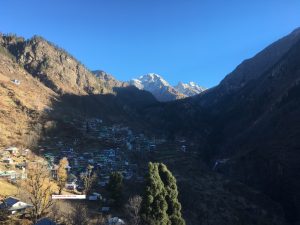 But, first things first. Time to feel fresh and have breakfast. The Cafe at Pinky Didi’s seemed like a nice place and the omelette with buttered bread was just the thing one desired.
But, first things first. Time to feel fresh and have breakfast. The Cafe at Pinky Didi’s seemed like a nice place and the omelette with buttered bread was just the thing one desired.
Tosh villagers have opened up homes for home stay with basic facilities and there is always a room to stay. Of course, in such scenic surroundings one tries to choose a place to stay with a view and so we did.
As I ventured out in the village in the morning hours I found facets of life those are unimaginable in city environments. First of all, there was pleasantry and simplicity in the air, which is a rarity in a city these days.
A small boy hanging out on the grill of his home’s balcony was a picture of inquisitiveness and innocence.
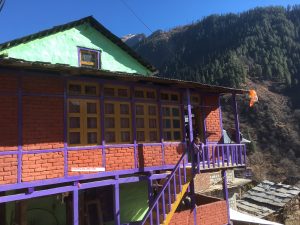 The Village School looked like a neatly wrapped textbook.
The Village School looked like a neatly wrapped textbook.
Signboards often reflect the educational level of the place and its marketing skills. But, who cares for English and presentation when all you want is good wholesome food in an inhospitable terrain.
 With this bounty of Nature unfolded before me, my poetic sensibilities came to fore and I started looking for the “solitary Highland Lass”, as written by William Wordsworth
With this bounty of Nature unfolded before me, my poetic sensibilities came to fore and I started looking for the “solitary Highland Lass”, as written by William Wordsworth
The Solitary Reaper
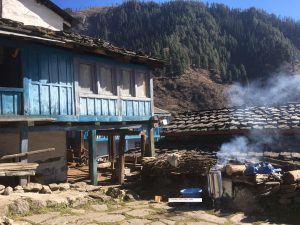 There was a closed village temple. A beautiful structure built in wood and carved in Himachali style, it appealed as a prominent building in the small village square. I read a signboard “Do not touch”. On inquiry I was informed that it is run by “Devtas” (spirits) and they had left yesterday, to return back after two and half months!
There was a closed village temple. A beautiful structure built in wood and carved in Himachali style, it appealed as a prominent building in the small village square. I read a signboard “Do not touch”. On inquiry I was informed that it is run by “Devtas” (spirits) and they had left yesterday, to return back after two and half months!“I lift up my eyes to the mountains—
where does my help come from?
My help comes from the Lord,
the Maker of heaven and earth.
He will not let your foot slip—
he who watches over you will not slumber;
indeed, he who watches over Israel
will neither slumber nor sleep.
The Lord watches over you—
the Lord is your shade at your right hand;
the sun will not harm you by day,
nor the moon by night.
It was cold and head and ears had to be well covered. Lunch was at a Cafe which served hot Dal and Cauliflower vegetable, which we ate more than we normally did. When the cold is biting you from everywhere, hot food is more than welcome!
It was time to relax and forget there was a worry in the world. People say that foreign tourists come here for the hash. World’s best hash is grown nearby in Malana.
Evening fell and what was a rocky mountain turned into gold! Such was the effect of awesome Nature!
My friend was brave enough to sit in the balcony during the night for some time and watch the stars. He found the night sky so romantic and clear, the stars nearer.
The flora at Tosh is Himalayan Blue Poppy, Iris, Marigold, Primulas, Buttercups and Balsam. They say you can once in a while see a brown or black bear. The rest of the sky is ruled by Lamagiers, Bull Finches and Rose Finches.
Next morning it was time to go ahead like travellers usually do and leave the visited place like a happy memory in the minds eye.
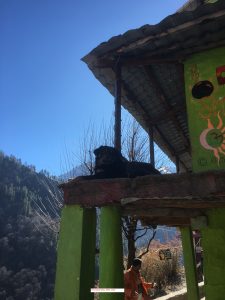 The shepherd dog will keep the watch and count the sheep! So must all tales be told and lived by others who follow in your footsteps!
The shepherd dog will keep the watch and count the sheep! So must all tales be told and lived by others who follow in your footsteps!
Distance: New Delhi to Toas by road 560 km; Route: Delhi-Ambala-Surendranagar- Roopnagar-Kasol-Barshana- Manikaran-Tosh.
Trek: Tosh to Kheerganga
Wo Duaon Ka Asar Hoga…by Sandeep Silas ‘deep’
WO DUAON KA ASAR HOGA…
Sandeep Silas ‘deep’
Wo duaon ka asar hoga, to zaroor mera hoga
Khuda ke samney mera sar, yun hi jhuka hoga
Wo dil jo mera hoga, to zaroor dhadakta hoga
Khuley aasman ki tarah, wo bhi simat-ta hoga
Wo khwaab subah ka hoga, to zaroor sachh hoga
Aftaab ki mauzoodgi mein, wo chand nikla hoga
Wo kis kadr mujhey chahega, uska noor kaisa hoga
Wo anjum-sabaah, nazuk mizaaj, paak ruh hoga
Wo shabnam ki tarah hoga, to khamosh barasta hoga
Bikhar-bikhar kar rom-rom, wo zaroor khilta hoga
Wo nagma-numah hoga, to saaz ke liye jeeta hoga
Sur aur lay ka roz, dekho, khushnumaah milan hoga
Tutey huey sitaron ka phir, koi naya jahan hoga
Wo ‘deep’ gar jala hoga, ghar-mandir ka hi hoga
Copyright: Sandeep Silas ‘deep’
(Written: Delhi; November 16 & 17, 2017)
Khajuraho…erotic art or spiritual quest? by Sandeep Silas
The very concept of erotic art sculpted on temple walls can raise eyebrows. Not so in Khajuraho!
I left Jhansi, 176 km from Khajuraho, photographing the wildflowers enroute and the River Ken. The road could have been better considering we connect a World Heritage Site, but still had its surprises of cattle being milked by villagers, children playing in front of their homes, fresh vegetables being sold by the road, and life caught up in the effort of living.
These temples were built by the Chandela dynasty between 950 AD to 1050 AD and have survived the ravages of weather and time to still tickle the senses of visitors. Originally 85 in a 20 km area, they stand only 25 in 6 kms today. Alberuni, the traveler historian calls it as a “city of gods”. Normally, one visualizes a temple as a place of worship of a deity. Now, whether the deity is human or the mind of a human thinks a deity to be part of his personal life is a question of debate?
Mark Cartwright, traveler and author writes about the architectural highlights of Khajuraho- “Most of the temples at Khajuraho were built using sandstone but four also used granite in their construction. In the latter group is the Chaunsat Yogini (64 tantric goddesses), built c. 875-900 CE, which has 64 shrine rooms arranged around a rectangular courtyard. Next in the site’s development came the Lalguan Mahadeva, Brahma, and Matangesvara temples which are all quite plain in design and decoration compared to the later temples.
The majority of temples at Khajuraho were constructed between 950 and 1050 CE and are either Hindu (Saiva or Vaisnava) or Jain. The most famous is the Kandariya Mahadeo built in the early 11th century CE and dedicated to Shiva. The more or less contemporary Laksmana temple was built in 954 CE by King Dhanga (r. 950-999 CE) to celebrate independence from the Gurjara-Pratihara rulers and has a similar layout and exterior to the Kandariya Mahadeo. So too does the Visvanatha temple (c. 1002 CE) which was designed by Sutradhara Chhichchha. Both temples have shrines at each corner of their terrace platforms. The Laksmana was dedicated to Vishnu and its terrace is of particular note as it carries a narrative frieze running around all four sides: Elephants, warriors, hunters, and musicians form a procession watched by a ruler and his female attendants.
Other notable temples at the site include the single-towered Chaturbhuja and Vamana, the squat Matulunga, and the rectangular, more austere Parshvanatha Jain temple with its unique shrine added to the rear of the building (c. 950-970 CE). Probably the latest temple at Khajuraho is the Duladeo which was built on a star-plan.” ( https://www.ancient.eu/Khajuraho/)
The eroticism of Khajuraho overshadows the rest of the hidden meanings of art. Sex, was not a bad word in those days as we see it being celebrated openly, encouraged and glorified on temple walls. Many meanings have been ascribed to the “why” of this art. One says, the Kings needed more men as soldiers so encouraged copulation, another looks into the hidden spirituality achieved through the meditative human sexual union.
But, all these fail to explain the man to animal and the unnatural forms of sex depicted on Khajuraho walls.
Whatever it is, the fact is that Khajuraho excites a visitor at any age and allows the person freedom of thought and expression. You come home satisfied you have seen art at a physical plane; you come back pondering you have seen the hidden spirituality within art; both equally satisfying feelings.
 Lady looking at her mirror image |Amorous couple
Lady looking at her mirror image |Amorous couple
The stunning and fabulous sculptures led the temple complex to be classified as a UNESCO World Heritage Site monument. Whatever exists is maintained very well by the Archaeological Survey of India. The temples are categorized into three groups: Eastern, Western and Southern.
 Lakshmi Sharath mentions some stories trying to explain the raison d’être of building these erotic temples- “The moon always evokes romance and it is little wonder then that the descendants of the celestial moon god would build monuments that stand for love. The story goes that a beautiful woman called Hemavathy was bathing in the dark under moonlight, when she was seduced by the moon himself. She ran into the forests for refuge and raised her son, Chandravarman alone. The moon however promised her that their son would one day rule over a kingdom. True to his word, Chandravarman grew up to establish the Chandela dynasty. It is believed that he was influenced by his mother’s story and so he built temples with sculptures depicting human passions and probably, the futility of the same.
Lakshmi Sharath mentions some stories trying to explain the raison d’être of building these erotic temples- “The moon always evokes romance and it is little wonder then that the descendants of the celestial moon god would build monuments that stand for love. The story goes that a beautiful woman called Hemavathy was bathing in the dark under moonlight, when she was seduced by the moon himself. She ran into the forests for refuge and raised her son, Chandravarman alone. The moon however promised her that their son would one day rule over a kingdom. True to his word, Chandravarman grew up to establish the Chandela dynasty. It is believed that he was influenced by his mother’s story and so he built temples with sculptures depicting human passions and probably, the futility of the same.
In case you are not fascinated with the story behind the erotic sculptures of Khajuraho, here is another belief that says the carvings of mithunas are symbols of “good luck” along with several sculptures that showcase mythical creatures. Another interpretation says they served as a form of sex education, by rekindling passions in the ascetic minds of people, who were probably influenced by Buddhism.

It is a depiction of the Hindu philosophy of Dharma, Artha, Kama, Moksha. Perhaps you can attain nirvana, once you are done with all your wordly pleasures.”(https://lakshmisharath.com/stories-erotic-sculptures-of-khajuraho/)
There is so much to see in Khajuraho and remember wondering about the apsaras, the nymphs engaged in activities like looking at the mirror; pulling out a thorn from the foot; fondling their breasts; tickling the private parts of their partners; holding a child; undressing; dancing; painting; or just being beauteous by themselves. There are warriors; horse & camel riders; there are the drummers going ahead of an army; there are mythical animals and attendants. In between the human endeavour the Gods and Goddesses are there too, placed under arched enclosures, as if blessing the whole exercise of recreation and human evolution. Here, the natural and the unnatural merge in the human consciousness that is governed by the law of love and nothing else.

 The law of love Mirror, mirror
The law of love Mirror, mirror
I came when the sun was brightest and by the time I finished my art appreciation the sky was overcast. I started hurrying to the far end of the temples to catch the last of the bright rays falling on statues before they were eaten up by the black clouds threatening rain. The mood of the sky changed suddenly as that of a human and it burst open sending rain-showers upon the beautiful damsels who live and dance on the walls of Khajuraho temples.
Dusk fell upon the warriors, lovers and damsels who are in an immortal frieze at Khajuraho. The cover of darkness was perhaps an encouragement to them to leave their stone forms and assume a human life in the night, before the next day’s dawn! 
Khajuraho is too complex to be understood by the ordinary senses. One has to delve deep into the mysteries of art & sculpture, and see with the discerning eye what all is hidden beneath the visible!
